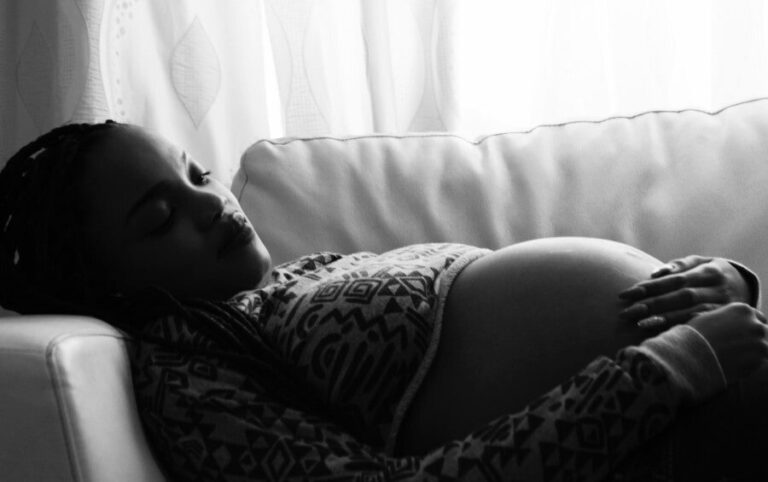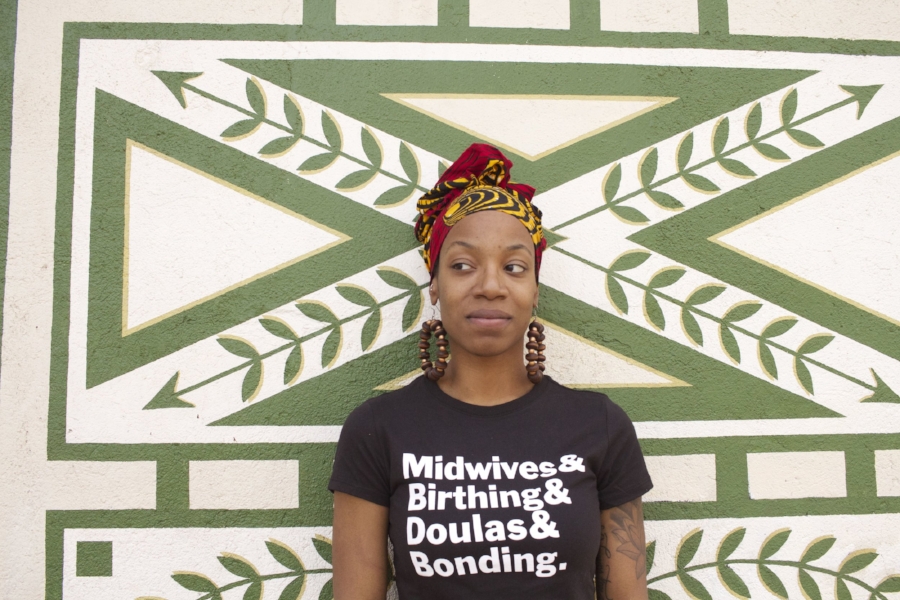Updated January 21, 2017 to reflect studies on home birth safety.
People have long associated giving birth with hospitals. It’s a connection that’s been reinforced for years through pop culture and reality—as of 2014, 98.5% of births happened in hospitals, according to the CDC. But more women are opting to bring their birthing experiences into their homes, choosing home births over giving birth in a hospital.
It seems as though Black women especially are becoming more interested in this alternative. Anecdotally, I’ve heard more new moms share their and seen more Instagram photos of moms curled up in beds, sofas and kiddie pools with their newborns instead of in hospital beds. And the women sharing these stories and photos weren’t just the crunchy granola mama type you’d expect to have unmedicated births—they were all over the map.
It’s a trend that Los Angeles-based student midwife Kimberly Durdin has noticed as well. While mainstream media and celebrities like musician/doula Erykah Badu have helped bring home birth into the spotlight, Kimberly says there’s another reason behind Black women’s growing interest in home births.

“I think all women are understanding that you can have more choices in your experiences of giving birth,” she explains. “[But] women of color have experienced many abuses in the health care system overall, and in childbirth in hospitals. We know all the statistics say we have the highest infant mortality—we’re 3-4x more likely to die after giving birth. Our babies are more at risk. I think home birth for suitable candidates is definitely a way to improve those statistics.”
It’s a prospect that’s becoming more attractive to women these days, but unmedicated, vaginal birth isn’t as simple as some would think.
“A lot of people think home birth is woo woo,” Kimberly says, laughing. “[Some] of the biggest misconceptions about home birth is that it’s going to go smoothly.”
Kimberly shares what women interested in giving birth outside of a hospital setting should know about this alternative.
Home Birth Isn’t For Everyone
Home births are for low-risk pregnancies and deliveries only. Women who have diabetes, high-blood pressure, or who have had C-sections may not be the best candidates for a home birth.
State laws also have a say in what midwives can do. “For instance,” Kimberly says, “in California home birth midwives can’t deliver breach of twins. However in other states, the laws may be different.”
Midwives will look at a potential client’s health records to determine if they are a good candidate for a natural birth, and keep track of the pregnant woman and baby’s health throughout the pregnancy to make sure they remain low-risk. (For example, checking to see if she develops preeclampsia during pregnancy or if the baby’s position isn’t conducive to an easy delivery.)
“It’s a constant conversation between the midwife [and] the client,” Kimberly says.
“As we assess her, we’re always on the lookout: Is this finding going to risk her out of care? Sometimes women do get risked out of home birth.”
But there are other ways to work with a midwife if you discover you’re not a good fit for a natural birth, Kimberly says.
“If they’ve built a rapport with their midwife, they may still choose to have their midwife continue to support them as they do concurrent care with a physician or even have their midwife be their doula,” she explains. “Or midwives do postpartum visits. There’s lots of different ways moms can benefit from the relationships and skills that a midwife has to offer even though she might have to transition to hospital-based care.”
Having A Home Birth Doesn’t Mean You’re Guaranteed A Perfect, Complication- And Intervention-Free Birth
A 2014 study published in the Journal of Midwifery and Women’s Health looked at the outcomes of 16,924 planned home births between 2004 and 2009, the largest analysis of its kind. It found that women with low-risk pregnancies had high rates of giving birth to perfectly healthy babies, and low rates of interventions such as epidurals or C-sections. But that doesn’t mean you’ll fall in that camp.
“Sometimes [people] think no matter what, the baby comes out at home even if that’s not the best place for it to be,” Kimberly says. “And that’s not the case.”
Even though you’ve planned to have a birth at home, sometimes complications arise that put you and the baby at risk, and are beyond your midwife’s scope of practice. (According to the aforementioned study, 89.1% of women who planned to have home births actually gave birth at home.) Prior to delivery, you and your midwife will have worked out a contingency plan for what to do in case you need to be transported to a hospital to deliver your baby.
[Some] of the biggest misconceptions about home birth is that it’s going to go smoothly.
“We work together to identify who the care will go to if we have to go from home to hospital,” Kimberly says. “Part of building trust during the prenatal visits is also talking about the what-ifs. If you don’t know what’s going to happen in the case of transport or emergency, then it’s much more stressful [if and when it happens].”
Midwives are trained to work out issues before delivery (e.g. getting the baby in a better position for delivery), recognize when matters are falling outside of their scope before and during delivery, and to work with moms to help them make informed decisions about transferring their care. This can include going to a predetermined hospital or having the paramedics on standby.
Having to transport your care to a hospital during your home birth doesn’t make you a failure—it’s important to keep you and your baby’s safety top of mind. It’s hard to predict whether or not a seemingly low-risk pregnancy will have complications come delivery time. But, as Kimberly points out, “the same types of complications can happen at a hospital.”
While there is always the chance for tragedy in both settings, recent studies have shown an increased risk for infant death in home births. Although the 2014 study in the Journal of Midwifery and Women’s Health found low rates of infant death in the home births, it’s a possibility that expecting mothers shouldn’t turn a blind eye to. As Pacific Standard reported:
“In December 2015, the New England Journal of Medicine published a study that followed the outcomes of 80,000 births in Oregon during the years 2012–13. The study showed that planned home births had a higher likelihood of neonatal seizures and carried twice the risk of neonatal death than did in-hospital births. These findings are perhaps not surprising, as they follow on the heels of a 2014 paper in the Journal of American Obstetrics and Gynecology, which found that planned home births with [certified professional midwives] CPMs, despite making up only 0.46 percent of total births in the study, resulted in four times as much neonatal death as did hospital births attended by nurse-midwives.”
Home Birth Has A Framework And Structure—And The Work Happens Before, During, and After Delivery
“Home birth is not an unguided, free-for-all birth experience,” Kimberly says. “Most healthcare providers who do birth at home follow the same schedule [as] an OB-GYN at a traditional hospital.”
Clients meet with their midwives for hour-long prenatal visits once a month for the first 28 weeks of pregnancy, either in their own homes or at the midwife’s office if she works out of one. From weeks 28 to 34, the visits happen every two weeks, and then once a week from week 34 to delivery. The prenatal visits are usually around an hour long.
“We do all the tests—blood tests, prenatal screenings, genetic testing, those sort of things you would do with your OB,” Kimberly explains. “We do refer out for other tests that we don’t typically do like ultrasounds.”
And the check-ins don’t stop after you’ve delivered—midwives also do postpartum check-ins for the first six weeks of your baby’s life.
Home Birth Is More Hands On
One of the principles guiding midwifery is informed consent—the idea that clients are making choices about their care from a place of understanding.
“Midwives want their clients to make well-informed choices about their care,” the North American Registry of Midwives states. “Information provided should be free from the personal bias of the practitioner and should be presented without coercion or intimidation. When all reasonable options have been discussed, and the client understands the possible outcomes of each option, it is the client’s right to choose her course of care.”
Midwifery is also more “high-touch, low-tech” than hospital births, Kimberly explains.
“We spend probably about 15 minutes of that time doing medical assessments—blood pressure, pulse, urine dipstick… different things we check for in the pregnancy,” she says. “And then we spend some time actually touching the mother, which is a hallmark of midwifery care. We assess the [baby’s] well-being by [checking its] heart rate as well as with our hands, assessing the size and position of the baby. We palpate her uterus. We show the mothers [and their partners] how to palpate their uterus. We get to know them in a more intimate way than just doing an ultrasound at every visit. It’s a wonderful bonding experience.
“We spend a good deal of time talking about nutrition, counseling, giving suggestions,” she continues. “We spend a lot of time talking about emotional well-being, what’s going on in their relationship, or anything the mom brings to the table. It is really important to us to build a foundation of trust and intimacy throughout the pregnancy.”
Home birth is not an unguided, free-for-all birth experience…
The same hands-on method is present during delivery, especially when it comes to handling non-emergency complications, like a stalled labor.
“Hospitals will probably put [the mom] on a lot of pitocin, give her an epidural if she doesn’t have one already, and just see what happens knowing that they have a C-section in their back pocket,” Kimberly explains. “But at home we would try things like getting moms dancing, walking, [and] eating to move her along.”
You’ll Need To Provide Some Supplies For Your Delivery
Midwives have their own kits filled with the tools they need to help with delivery. This includes a birthing chair, which helps you get into a comfortable, squatting position for delivery, and a birthing tub for water births (though some families opt to buy their own).
However, your midwife may ask that you provide a few other supplies for the big day. “They’re all very easy-to-pick-up things,” Kimberly says. “Lots of towels that you’re not going to need to use again; Chux pads, which are absorbent, disposable pads; sanitary napkins for postpartum; sterile gloves. It’s not a lot, usually people spend about $100 or so for those additional supplies.”
You’ll Need To Do Your Research
In some ways the relationship between midwife and client is far more intimate and reliant on trust than you may find with a doctor-patient relationship. That’s why it’s important to search for your midwife with that potential bond in mind.
“When you interview a midwife, first notice how you feel in their presence,” Kimberly advises. “If you feel comfortable, if you feel safe, if the energy that you’re feeling between you feels right, that’s a good place to start. Feeling out ‘Is this person a good fit for me energetically?’ is number one.”
Then you can ask other experience-probing questions such as:
- What’s your training?
- What’s your scope of practice? What things can you do and not do?
- How many births have you attended?
- Do you have any children of your own? (“Not that it necessarily matters,” Kimberly says, “but it might matter to you.”)
- How much do you cost? (Prices vary from state to state, city to city. In Los Angeles, Kimberly says the average cost of a midwife’s services is $5,000-$6,000 “which would include all of the prenatal visits; all of the postpartum visits, which we do typically four of them in the first six weeks postpartum; and the birth.”)
- What’s your payment schedule?
- Do you accept insurance, and if not, how can you work with me?
And Yes, It’s Going To Hurt
“With home birth, there [are] no buffers to help you get from Point A to Point B,” Kimberly explains. “If you have issues with pain, and you’re choosing homebirth, then you’re going to have to find out ways to deal with the inevitable pain and discomfort without a drug that’s going to take that sensation away. And that requires work on mind, body, and spirit.”
There are a variety of pain management options midwives and can walk you through, including water birth, which said greatly reduced the pressure she felt during labor, and Hypnobirthing, a method that combines meditation, breathing, visualization, and other wellness practices that can help mothers relax.
This is by no means an exhaustive look at all the ins and outs of natural birth, but we hope it’s a helpful start as you consider your options for a happy and healthy pregnancy and delivery. And if you’re definitely set on having a natural delivery, “be happy!” Kimberly says, laughing.
“Pat yourself on the back. It’s not about being brave to have your baby—you’re going to have your baby anyway. You’re courageous because you made a decision to go against the mainstream.”

















